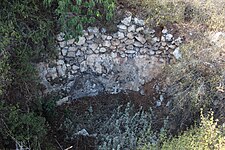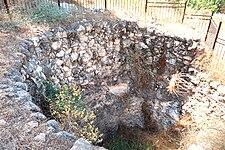Limepit

A limepit is either a place where
Primitive limepits
The production of lime in the


In Bedouin-Arab culture in Palestine, the limepit was dug to a depth of about 2.5 metres (8.2 ft) and about 3 metres (9.8 ft) in diameter. By all appearances, the pit was made after the same basic principle used in a "
When properly burnt, limestone loses its
Basic design
Many limepits were sunken in the ground at a depth of between 2.5 and 5 meters and 3 to 4.5 meters in diameter, in a circular fashion, and some were built with a
Lime is derived from chalk [sic] by burning. The Bedouins used it in plastering their cisterns. Burning chalk stone was performed in simple kilns in close proximity to where the chalk was found. Lime kilns were made by digging a round hole, three metres wide, two and a half metres deep. After the hole was dug, the chalk and fuel for a fire would be brought to it. Stones of chalk (limestone) would be arranged in a circular dome in the pit. The burning process would last three to six days, without letup. After the burning was finished, the kiln would be left to cool for four to six days. The lime would then be taken out. The large lime blocks along the edge of the pit were considered of the highest quality, while the small pieces towards the center of the pit were considered grade B. One camel load, or cantur (qentar / quntar = 100 ratels, or 250-300 kilograms), of lime would fetch 40 grush on the Jerusalem market in the early 1880s.[11]
In
Chemical changes
The lime stones selected were those that had the least amount of impurities within them. Limepits were almost always built near the supply of limestone, and a sufficient pile of wood kindling was heaped in great store before the actual burning process began, a supply that was to last between 3 and 7 days of continual burning, both, by night and day. In the southern Mediterranean regions, one of the favorite wood sources was thorny burnet (
Gallery
-
Limepit in the Jewish National Fund Forest, near Nes Harim
-
Ancient limepit in Jerusalem
-
Lime kiln in Judaea, in the Angels Forest, Shahariyya, near Kiryat Gat
-
Lime pit in Judaea, the Angels Forest
See also
- Lime kiln
- Lime plaster
- Qadad (Method of waterproofing cisterns in South Arabia)
References
- ^ Mizrachi, Yonatan (2008): Photo - p. 3
- ^ Zilberbod, Irina (2006): Photo - p. 3; English - Final Report; Image
- ^ Be'eri, Ron (2012): Photo - p. 12; English - Final Report; Image
- ^ Eliyahu-Behar, A., et al. (2017), p. 15
- ^ a b Eliyahu-Behar, A., et al. (2017), p. 28
- ^ Fraiberg, Alexander (2013): Photo - p. 7
- ^ Slaking is a strongly exothermic reaction in which quicklime absorbs hydrogen and oxygen from water to produce lime — a fine-grained white powder (Eliyahu-Behar, A., et al. 2017).
- ^ a b Young, Clyde; Engel, Bernard (1943), p. 250
- ^ Eliyahu-Behar, A., et al. (2017), p. 29
- ^ Cohen, Amnon (1989), p. 81
- ^ a b Abu-Rabiʻa, ʻAref (2001), p. 46
- ^ Dalman (2013), vol. 2, pp. 384, 565
- ^ a b c Spanier, Y. & Sasson, A. (2001), p. 7 (Preface)
- ^ Dalman (2013), vol. 2, p. 384
Bibliography
- Abu-Rabiʻa, ʻAref (2001). Bedouin Century: Education and Development among the Negev Tribes in the Twentieth Century. New York: Berghahn Books. OCLC 47119256.
- Be'eri, Ron (2012). "Neve Yaakov". Hadashot Arkheologiyot: Excavations and Surveys in Israel (in Hebrew). 124. JSTOR 26601314.
- Cohen, Amnon (1989). Economic Life in Ottoman Jerusalem. Cambridge: ISBN 0521365511.
- OCLC 1040774903.
- Eliyahu-Behar, A.; Yahalom-Mack, N.; Ben-Shlomo, D. (2017). "Excavation and Analysis of an Early Iron Age Lime Kiln", Israel Exploration Journal 67, pp. 14–31
- Fraiberg, Alexander (2013). "Nahal Lakhish (The Lachish Valley)". Hadashot Arkheologiyot: Excavations and Surveys in Israel. 125. JSTOR 26602840.
- Mizrachi, Yonatan (2008). "Kiryat Ye'arim (Final Report)". Hadashot Arkheologiyot: Excavations and Surveys in Israel (in Hebrew). 120. JSTOR 26592581.
- Spanier, Yossi; Sasson, Avi (2001). Limekilns in the Land of Israel (כבשני סיד בארץ-ישראל) (in Hebrew). Ariel: Jerusalem: OCLC 48108956.
- Young, Clyde; Engel, Bernard, eds. (1943), Spons' Practical Builders' Pocket Book – A Reference Book of Memoranda, Tables and Official Rules and Regulations for Architects and Builders (8 ed.), London: E. & F.N. Spon, Ltd., OCLC 156000531
- Zilberbod, Irina (2006). "Har Giora (East)". Hadashot Arkheologiyot: Excavations and Surveys in Israel (in Hebrew). 118. JSTOR 26583841.




